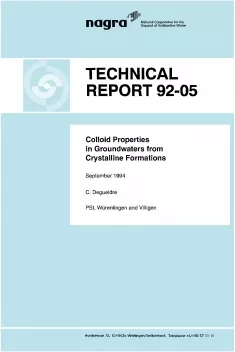
Technical Report NTB 92-05
Colloid Properties in Groundwaters from Crystalline Formations
Colloids are present in all groundwaters. The role they may play in the migration of safety-relevant radionuclides in the geosphere therefore must be studied. Colloid sampling and characterisation campaigns have been carried out in Switzerland. On the basis of the results obtained from studies in the Grimsel area (Grimsel Test Site, Transitgas tunnel), Northern Switzerland (Leuggern, Zurzach) and the Black Forest (Bad Säckingen, Menzenschwand), as well as those obtained by other groups concerned with crystalline formation waters (Canada, Sweden, France, Spain), a consistent picture is emerging.
The groundwater colloids in crystalline formations are predominantly comprised of phyllosilicates and silica originating from the aquifer rock. Under constant hydrogeochemical conditions, the colloid concentration is not expected to exceed 100 ng·ml-1 when the calcium concentration is greater than 10-4 M. However, under transient chemical or physical conditions, such as geothermal or tectonic activity, colloid generation may be enhanced and the colloid concentration may reach 10 μg·ml-1 or more, if both the calcium and sodium concentrations are low (i.e. < 10-4 M and < 10-2 M, respectively). In the Nagra Crystalline Reference Water ([Ca] = 3.5 × 10-4 M, [Na] = 1.4 × 10-2 M, [TOG] = 3 × 10-6 M), the expected colloid concentration is < 100 ng·ml-1. This can be compared, for example, to a colloid concentration of about 10 ng·ml-1 found in Zurzach water. The small colloid concentration in the reference water is a consequence of an attachment factor for clay colloids (montmorillonite) close to 1.
A model indicates that at pH 8, the nuclide partition coefficients between water and colloids (Kp) must be smaller than 107 ml·g-1 if sorption takes place by surface complexation on colloids, =AIOH active groups forming the dominant sorption sites. This pragmatic model is based on the competition between the formation of nuclide hydroxo complexes in solution and their sorption on colloids. Experimental nuclide sorption data on colloids are compared with those obtained by applying this model. For a low colloid concentration (< 100 ng·ml-1 with sizes from 10 to 1000 nm), a sorption capacity of the order of 10-9 M and reversible surface complexation (Kp < 107 ml·g-1 at pH 8), their presence in the crystalline rock aquifer can be ignored in the safety analysis.
Studies of colloid-facilitated nuclide transport have shown that the classical surface complexation/ion exchange equilibrium model is not conservative. Reversible attachment of colloids onto the rock should be taken into account, together with irreversible sorption of radionuclides onto these colloids. A colloid contribution to transport could be claimed when nuclide sorption on a colloid is followed by colloid aggregation, producing irreversible sorption. However, if any significant aggregation occurs, sedimentation of the larger particles would also occur. The study shows that, with a conservative size distribution, such a sorption-agglomeration process resulting in potential irreversible sorption onto colloids is very unlikely in the water-conducting zones and for the chemistry of the Crystalline Reference Water.
